SequentialMRI
- class deepinv.physics.SequentialMRI(mask: Tensor | None = None, img_size: tuple | None = (320, 320), three_d: bool = False, device='cpu', **kwargs)[source]
Bases:
DynamicMRISingle-coil accelerated magnetic resonance imaging using sequential sampling.
Let \(M\) be a subsampling mask with given acceleration. \(M_t\) is a time-varying mask with the sequential sampling pattern e.g. non-overlapping lines or spokes, such that \(S=\bigcup_t S_t\). The sequential MRI operator then simulates a time sequence of k-space samples:
\[y_t = M_t F x\]where \(F\) is the 2D discrete Fourier Transform, the image \(x\) is of shape (B, 2, H, W) and measurements \(y\) is of shape (B, 2, T, H, W) where the first channel corresponds to the real part and the second channel corresponds to the imaginary part.
This operator has a simple singular value decomposition, so it inherits the structure of
deepinv.physics.DecomposablePhysics()and thus have a fast pseudo-inverse and prox operators.A fixed mask can be set at initialisation, or a new mask can be set either at forward (using
physics(x, mask=mask)) or usingupdate_parameters.Note
We provide various random mask generators (e.g. Cartesian undersampling) that can be used directly with this physics. See e.g.
deepinv.physics.generator.mri.RandomMaskGenerator- Parameters:
mask (torch.Tensor) – binary mask \(S_t,t=1\ldots T\), where 1s represent sampling locations, and 0s otherwise. The mask size can either be (H,W), (T,H,W), (C,T,H,W) or (B,C,T,H,W) where H, W are the image height and width, T is time-steps, C is channels (typically 2) and B is batch size.
img_size (tuple) – if mask not specified, flat mask of ones is created using
img_size, whereimg_sizecan be of any shape specified above. If mask provided,img_sizeis ignored.device (torch.device) – cpu or gpu.
- Examples:
Single-coil accelerated sequential MRI operator:
>>> from deepinv.physics import SequentialMRI >>> x = torch.randn(1, 2, 2, 2) # Define random image of shape (B,C,H,W) >>> mask = torch.zeros(1, 2, 3, 2, 2) # Empty demo time-varying mask with 3 frames >>> physics = SequentialMRI(mask=mask) # Physics with given mask >>> physics.update_parameters(mask=mask) # Alternatively set mask on-the-fly >>> physics(x).shape # MRI sequential samples torch.Size([1, 2, 3, 2, 2])
- A(x: Tensor, mask: Tensor | None = None, **kwargs) Tensor[source]
Applies the forward operator \(y = A(x)\).
If a mask/singular values is provided, it is used to apply the forward operator, and also stored as the current mask/singular values.
- Parameters:
x (torch.Tensor) – input tensor
mask (torch.nn.Parameter, float) – singular values.
- Returns:
(torch.Tensor) output tensor
- A_adjoint(y: Tensor, mask: Tensor | None = None, keep_time_dim=False, **kwargs) Tensor[source]
Computes the adjoint of the forward operator \(\tilde{x} = A^{\top}y\).
- Parameters:
y (torch.Tensor) – input tensor
mask (torch.nn.Parameter, float) – input mask
keep_time_dim (bool) – if
True, adjoint is calculated frame-by-frame. Used for visualisation. IfFalse, flatten the time dimension before calculating.
- Returns:
(torch.Tensor) output tensor
Examples using SequentialMRI:

Self-supervised MRI reconstruction with Artifact2Artifact